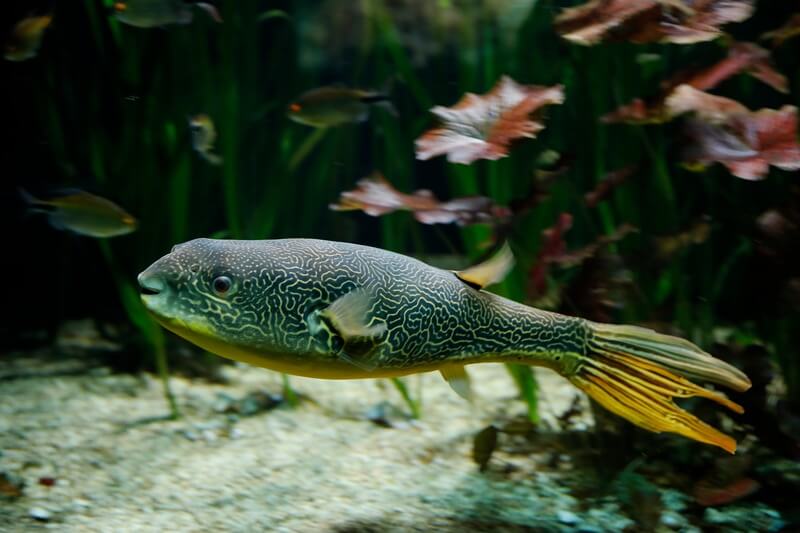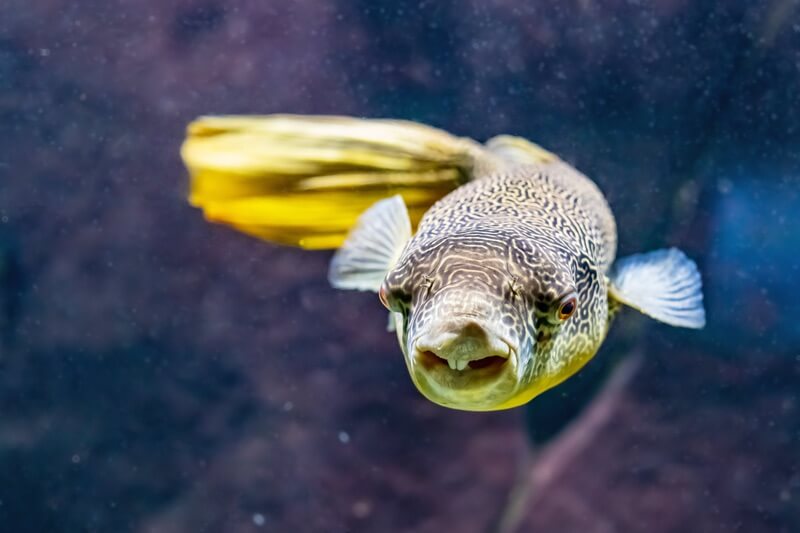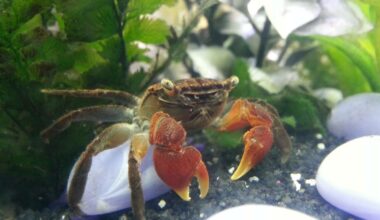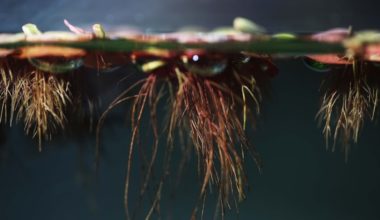The Mbu puffer fish is an incredibly unique species that has quite a personality. Known for being very intelligent and fun to observe, this freshwater fish has gotten the attention of many aquarists over the years.
This guide will teach you the essentials of Mbu puffer care. Tank size, food, and water parameters are just a few of the topics it covers!
Table of Contents
Species Summary
While smaller puffer fish are common in the fish-keeping community, the Mbu puffer (Tetraodon mbu) is rare and highly sought-after. This species is the largest in the Tetraodon family. It’s also known as the giant puffer or giant freshwater puffer.
Native to rivers and lakes in Africa, the Mbu puffer fish lives exclusively in freshwater. While that eliminates the challenge of figuring out the right balance of salinity, Mbu puffer care is not easy.

The sheer size of this fish presents unique challenges you don’t encounter with smaller species. It requires a lot of room, constant tank maintenance, and a well-designed habitat.
That said, those who are dedicated will fall in love with the Mbu puffer fish! Capable of recognizing its owner, these fish exude playful energy and become much more than just a display pet.
Appearance
The appearance of the Mbu puffer fish is similar to its smaller cousins. The top of the body is deep olive-green while the belly fades to a soft yellow. A distinct pattern of random swirls adorns the skin, creating a maze-like appearance that stands out.
The fish’s silhouette is oblong and somewhat flat. But like all other puffers, it can quickly balloon in size when stressed or frightened.
The fins are small and semi-transparent. The only exception is the caudal fin. It’s a bit longer and sports a complementary striped pattern that mimics the rest of the body.
Mbu puffers don’t have scales. The skin is smooth and delicate, which can present some problems in the safety department. Fortunately, it’s easy to avoid major accidents with some careful planning and appropriate decor.
The head is, perhaps, one of the most exciting parts of this fish! They have large, beady eyes that grow further apart as the puffer ages. Instead of a standard upturned mouth like most fish, the Mbu puffer fish has a beak-like orifice.
Author Note: The beak is expressive and contributes to the quirky look of the fish. Not only that, but it’s what makes eating their diet of shellfish and mollusks possible!
Lifespan
The average lifespan for the Mbu puffer fish is about ten years in captivity. They’re thought to live much longer in the wild, but a decade is the norm for those living in a confined habitat.
As always, there are no guarantees with life expectancy. Several factors impact their resilience to disease and overall longevity. In addition to genetics, the quality of care you provide will have a massive impact on the amount of time you have with them..
Average Size
These fish are massive! The typical Mbu puffer size is 22 inches in length on the lower end, and 30 inches or more for larger specimens.
The exact size you can expect will depend largely on the environment you keep these freshwater fish in. Fish kept in larger vessels tend to reach the upper ends of the size spectrum.
Either way, Mbu puffers aren’t like the small puffer fish you see in pet stores. Their large size is one of the biggest hurdles to ownership, as they need ample space to stay healthy and thrive.
Mbu Puffer Care
Mbu puffer care isn’t for the faint of heart. Most fish enthusiasts and experts agree that this species is best for those with a bit of experience.
Whether you’re a first-time puffer fish owner or a seasoned fishkeeper looking to add a unique species to your collection, caring for the Mbu puffer is a tall order. To help you get started, here are some established guidelines that you should follow.
Tank Size
Let’s start with the first challenge you’ll need to overcome, tank size.
The recommended Mbu puffer tank size is at least 500 gallons for adults, and that’s the bare minimum. If possible, it’s best to provide closer to 1,000 gallons.
Most owners resort to custom-built aquariums or carefully maintained ponds. With a fish of this size, swimmable space is more important than overall volume. As a result, you need to pay attention to the dimensions of your tank or pond, too.
Author Note: The ideal habitat dimensions for Mbu puffer fish is around 96 inches long, about 48 inches wide, and 24 to 36 inches deep. With those dimensions, the fish will have ample room to swim without feeling cramped.
Water Parameters
The best way to keep the Mbu puffer healthy is to replicate its natural environment as closely as possible. These fish are native to warm bodies of water in Africa. They prefer warm climates with slightly acidic water and moderately low hardness.
Mbu puffer fish are a bit sensitive to poor conditions. Unfortunately, they also happen to produce a ton of waste.
Staying on top of water parameters and overall quality is one of the most important parts of Mbu puffer care. Test the water regularly with a reliable kit and perform weekly water changes to keep things stable.
- Water temperature: 75 to 79 degrees Fahrenheit
- pH levels: 7.0 to 8.0 (around 7.5 is ideal)
- Water hardness: 10 to 25 KH
How To Set Up The Inside Of Their Tank
As far as decorations go, an all-natural environment is always best.
Start with a soft sand substrate. Mbu puffer fish aren’t bottom feeders, but they frequently venture to the bottom of the water column for feeding. Pebbles and gravel could pose a safety risk to the fish’s delicate skin.
On top of the substrate, add some smooth rocks and small pieces of driftwood. The most important thing is to avoid any sharp edges.
Author Note: It doesn’t take much to injure this fish. Injuries are even more common if they inflate in overcrowded environments with pointy decor. Keep things simple and focus on softer items if possible.
Plants are an excellent addition to the tank. Mbu puffers can be a little destructive if food falls onto plant leaves. But for the most part, they’ll enjoy swimming through the plants and hiding.
Arrange the plants around the tank’s perimeter. Standard aquatic cultivars like Java fern and Anubias work just fine.
Potential Diseases
Unfortunately, Mbu puffer fish can be a bit more susceptible to disease than other freshwater fish. That’s because they don’t have the protection that comes with scales.

These fish are vulnerable to a wide range of ectoparasites. The one that wreaks havoc the most is Ichthyophthirius multifiliis. It’s responsible for white spot disease, which is also known as ich.
Ich manifests itself through a series of visible white dots all over the fish. The disease is highly contagious and quickly spreads through a closed environment.
Thankfully, the condition is pretty easy to treat with over-the-counter medications. The trick is catching it early enough and quarantining infected fish before it spreads.
While it’s impossible to make your Mbu puffer immune to disease, you can do your part to limit exposure. Monitor water conditions regularly to keep your fish stress-free and healthy. Before adding any tank mates, plants, or decor, make sure they’re clean and parasite-free.
Food & Diet
The Mbu puffer fish is considered a molluscivore. That means it’s a carnivore that feeds primarily on mollusks, snails, shellfish, and other similar animals.
Providing an appropriate diet can be challenging. It’s not just about meeting dietary needs. Mbu puffers also need to consume hard foods (which can be more work for you as an owner).
Author Note: They require shelled mollusks and snails because they use the hard texture to keep their beaks maintained. Eating only soft foods will let the beaks grow to the point where it’s difficult for the fish to eat at all.
The preferred diet for an Mbu puffer includes foods like:
- Clams
- Mussels
- Snails
- Crayfish
- Crab
- Worms
- Shrimp
It’s best to provide hard-shelled food items at least five times a week. You can also add softer foods into the rotation to give some variety.
Mbu puffer fish willingly eat live or frozen food. If you choose to provide live food, make sure you prepare them to avoid damage. For example, it’s a good idea to remove claws from crabs and crayfish to ensure that they don’t harm the fish in any way.
Behavior & Temperament
Mbu puffers are a playful species that likes to interact with owners. They’re pretty intelligent and can even learn to recognize owners after a while!
Some fish may become more active when you approach the tank because they think it’s feeding time. Others may inflate themselves to get attention!

These fish are quirky, and their personalities can vary wildly from fish to fish.
When they’re not vying for attention, Mbu puffers will spend most of their day exploring. They’re fond of plants and will frequently swim in and out of vegetation for fun.
As far as temperament goes, Mbu puffer fish aren’t team players. They’re very territorial and can get aggressive with any creature that bothers them.
That includes other Mbu puffers. You should never keep these fish in pairs or groups. Otherwise, fighting will occur.
Mbu Puffer Tank Mates
Mbu puffer fish are considered too aggressive to keep with other fish. They’re best when living in solitude. Fortunately, they don’t mind living alone.
Now, all fish are different. Some owners see great success keeping their Mbu puffer with other small peaceful species.
Author Note: The consensus is that Mbu puffers tend to ignore fish that aren’t trying to eat the same foods. In theory, you could keep them with fish like guppy fish, many types of tetras, and other peaceful community fish.
But keep in mind that there are no guarantees. Mbu puffers have the teeth to make quick work of any tank mate they don’t like. It’s a game of hit and miss with these guys, so introduce potential tank mates with caution.
Breeding
Currently, it’s not possible to breed the Mbu puffer in captivity.
Some commercial breeders have been successful. However, most of the fish you see on the market today are wild-caught.
It’s impossible to trigger spawning in standard home aquarium setups. There’s not enough space and the environmental cues are too risky to attempt.
If a way to safely and reliably breed these fish in captivity is discovered, we’ll make sure to add it to the list.
Conclusion
While Mbu puffer care is challenging, it’s more to do with the cost and tank commitment than anything else. If you have the room (and the money) to accomodate this species with a large tank that’s also well-maintained, you’ve already won half the battle.
These fish aren’t finicky or high-maintenance. They just need a big tank and a lot of food. So if this doesn’t bother you, give them a chance!

